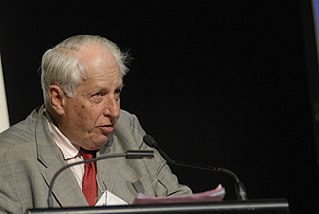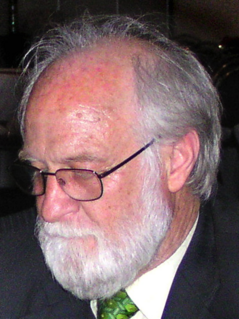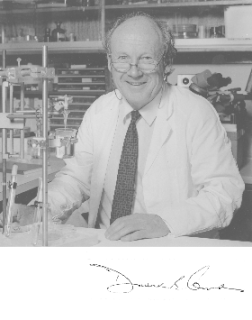Related Research Articles

Sir Gustav Victor Joseph Nossal is an Austrian-born Australian research biologist. He is famous for his contributions to the fields of antibody formation and immunological tolerance.
Nancy Fannie Millis was an Australian microbiologist and Emeritus Professor who introduced fermentation technologies to Australia, and created the first applied microbiology course taught in an Australian university.

The Australian Academy of Science was founded in 1954 by a group of distinguished Australians, including Australian Fellows of the Royal Society of London. The first president was Sir Mark Oliphant. The Academy is modelled after the Royal Society and operates under a Royal Charter; as such, it is an independent body, but it has government endorsement. The Academy Secretariat is in Canberra, at the Shine Dome.
Keith Edward Bullen FAA FRS was a New Zealand-born mathematician and geophysicist. He is noted for his seismological interpretation of the deep structure of the Earth's mantle and core. He was Professor of Applied Mathematics at the University of Sydney in Australia from 1945 until 1971.
Andrew Cockburn FAA is an Australian evolutionary biologist who has been based at the Australian National University in Canberra since 1983. He has worked and published extensively on the breeding behaviour of antechinuses and superb fairy-wrens, and more generally on the biology of marsupials and cooperative breeding in birds. His work on fairy-wrens is based around a detailed long-term study of their curious mating and social system at the Australian National Botanic Gardens.

Kenneth Charles Freeman is an Australian astronomer and astrophysicist who is currently Duffield Professor of Astronomy in the Research School of Astronomy and Astrophysics at the Mount Stromlo Observatory of the Australian National University in Canberra. He was born in Perth, Western Australia in 1940, studied mathematics and physics at the University of Western Australia, and graduated with first class honours in applied mathematics in 1962. He then went to Cambridge University for postgraduate work in theoretical astrophysics with Leon Mestel and Donald Lynden-Bell, and completed his doctorate in 1965. Following a postdoctoral appointment at the University of Texas with Gérard de Vaucouleurs, and a research fellowship at Trinity College, Cambridge, he returned to Australia in 1967 as a Queen Elizabeth Fellow at Mount Stromlo. Apart from a year in the Kapteyn Institute in Groningen in 1976 and some occasional absences overseas, he has been at Mount Stromlo ever since.

Peter Gavin Hall was an Australian researcher in probability theory and mathematical statistics. The American Statistical Association described him as one of the most influential and prolific theoretical statisticians in the history of the field. The School of Mathematics and Statistics Building at The University of Melbourne was renamed the Peter Hall building in his honour on 9 December 2016.
John Stuart Anderson FRS, FAA, was a British and Australian scientist who was Professor of Chemistry at the University of Melbourne and Professor of Inorganic Chemistry at the University of Oxford.

Professor Kurt Lambeck AC, FRS, FAA, FRSN is Professor of Geophysics at the Australian National University in Canberra, Australia. He has also taught at University of Paris and at Smithsonian and Harvard Observatories.

Brian David Outram Anderson is Professor in the Research School of Information Sciences and Engineering at the Australian National University. His research interests include circuits, signal processing and control, and his current work focuses on distributed control of multi-agent systems, sensor network localization, adaptive and non-linear control. Professor Anderson served as President of the Australian Academy of Science from 1998 to 2002.

Ronald David Ekers FRS FAA is an Australian radio astronomer. His fields of specialty include the study of active galactic nuclei, cosmology, and radio astronomy techniques.

Noel Sydney HushAO FRS FNAS FAA FRACI FRSN was an Australian chemist at the University of Sydney.
Kliti Grice, is a Chemist, an Organic and Isotope Geochemist and Earth Scientist known for her work in identifying geological and environmental causes for mass extinction events. Her multidisciplinary research integrates geological information with data on molecular fossils and their stable carbon, hydrogen and sulfur isotopic compositions to reconstruct details of microbial, fungal and floral inhabitants of modern and ancient aquatic environments and biodiversity hot spots. This information expands our understanding of both the Earth's history and its current physical state, with implications ranging from energy and mineral resource exploration strategies to environmental sustainability encompassing climate dynamics and expected rates, durations and scale of our future planet's health. As one of the youngest women professors in Earth Sciences, she is the founding director of the Western Australian Organic and Isotope Geochemistry Centre (WA-OIGC) and is a Professor of Organic and Isotope Geochemistry at Curtin University in Perth, Western Australia.
The Matthew Flinders Medal and Lecture of the Australian Academy of Science is awarded biennially to recognise exceptional research by Australian scientists in the physical sciences. Nominations can only be made by Academy Fellows.
Michael Newton Barber is a mathematician, physicist and academic. He was Vice Chancellor of Flinders University in South Australia from 2008 until 2014.
Barry William Ninham AO DSc FAA is an Australian physicist who has received many awards for his research.

David Roderick Curtis AC MB BS PhD FRACP FAA FRS was an Australian pharmacologist and neurobiologist.
Professor William Henry Wittrick FAA FRS (1922–1986) was a British engineer and academic who spent 20 years in Australia, including 10 years as Professor of Aeronautical Engineering at the University of Sydney (1956–1964). He was Professor of Structural Engineering at the University of Birmingham (1964–69), and Beale Professor of Civil Engineering, University of Birmingham (1969–82).
Brian Leslie Norman Kennett is a mathematical physicist and seismologist. He is now a professor emeritus at the Australian National University.
References
- ↑ "Compston, William (1931 - )". Biographical entry. Encyclopaedia of Australian Science.
- ↑ "Professor Bill Compston". Fellow. Australian Academy of Science.
- ↑ "Compston, William, FAA, FRS (1931-)". trove.nla.gov.au.
- ↑ David Salt (2005). "Professor Bill Compston, isotope geochemist". Interviews with Australian scientists. Australian Academy of Science.
- ↑ "History". Archived from the original on 7 October 2011. Retrieved 7 December 2011.
- ↑ "History - Compston". SHRIMP. anu.edu.au.
- ↑ "Centenary Medal". It's an Honour. 1 January 2001.
For service to Australian Earth Science and Instrumental Development
- ↑ "Matthew Flinders Medal and Lecture". Australian Academy of Science.
- ↑ "Mawson Medal and Lecture". Australian Academy of Science.